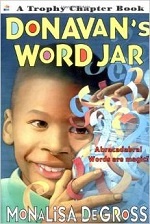Word Collecting

I like to collect new words….. in fact, I have a large, glass jar on the top of my desk where I keep slips of paper with new words that cross my path. If a word catches my interest, I find and write its definition, use it in a sentence, and add this to a slip of paper that goes in the jar.
I just added this new word: “jonesing”, which means “craving, wanting really badly” (InternetSlang.com) and “to have a strong need or desire for something” (urbandictionary.com). I met the word via a friend who has used it several times in writing and conversation, as in an email message that noted “I am jonesing to go skiing in the mountains.”
I got the idea of a word jar when I read and started sharing an elementary book “Donovan’s Word Jar” by Mona Lisa DeGross. It’s a  story about a boy with friends who have collections – coins, comics, baseball cards. Donovan decides to collect words, in a jar. Part of the story is how Donovan uses and shares his words. If you are an elementary teacher, this is a great book to use as a read-aloud with students.
story about a boy with friends who have collections – coins, comics, baseball cards. Donovan decides to collect words, in a jar. Part of the story is how Donovan uses and shares his words. If you are an elementary teacher, this is a great book to use as a read-aloud with students.
How do we learn a new word? As we note in The Key Vocabulary Routine, we don’t learn words by looking them up in a dictionary. We learn them by taking an interest in them and encountering them multiple times in context. Slowly, over time, we gradually get to know a word and make it our own. Here are two examples from this past weekend for me:
- My friend used the term “jonesing” again, this time in conversation. This second encounter was enough to peak my interest enough to add it to my jar.
- This same weekend I went on an architectural tour, and the guide used the term “tessellate” (to arrange in a checkered or repeated mosaic pattern). I know and own this word because last year I took an interest in it, added it to my jar, and started using it.
If you really want to own a word, you have to use it yourself in the right context. For example, by writing I am jonesing to hear from my friend so I can learn more cool words and by writing about “jonesing” in this blog, there’s good chance I will not forget the word.
Teachers should find every opportunity they can to develop a sense of word consciousness in their students. Start a word jar in your classroom, share books like Donovan’s Word Jar, let students know that you get excited to learn a new word. I’ll end this post with a great quote from the National Center on Education and the Economy:
“Teachers should encourage children to become WORD COLLECTORS, people who notice new words and scoop them up for their personal collections when they hear, see or read them.”

 Joan Sedita is the founder of Keys to Literacy and author of the Keys to Literacy professional development programs. She is an experienced educator, nationally recognized speaker and teacher trainer. She has worked for over 35 years in the literacy education field and has presented to thousands of teachers and related professionals at schools, colleges, clinics, and professional conferences.
Joan Sedita is the founder of Keys to Literacy and author of the Keys to Literacy professional development programs. She is an experienced educator, nationally recognized speaker and teacher trainer. She has worked for over 35 years in the literacy education field and has presented to thousands of teachers and related professionals at schools, colleges, clinics, and professional conferences.
Leave a Reply